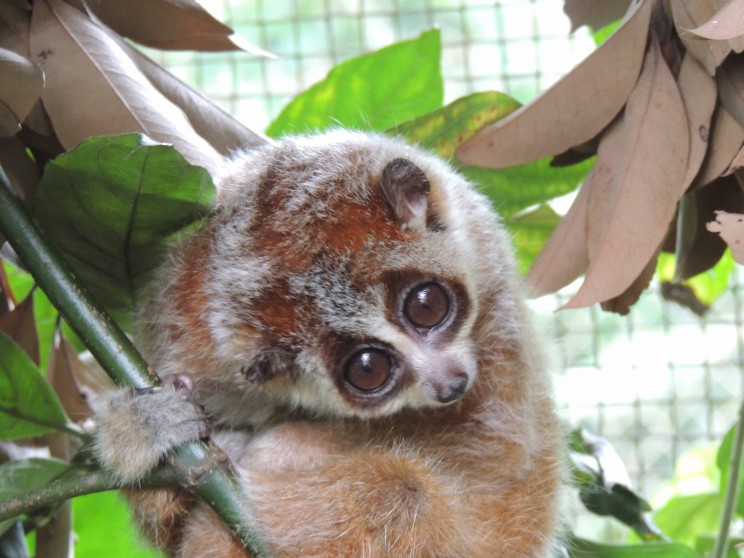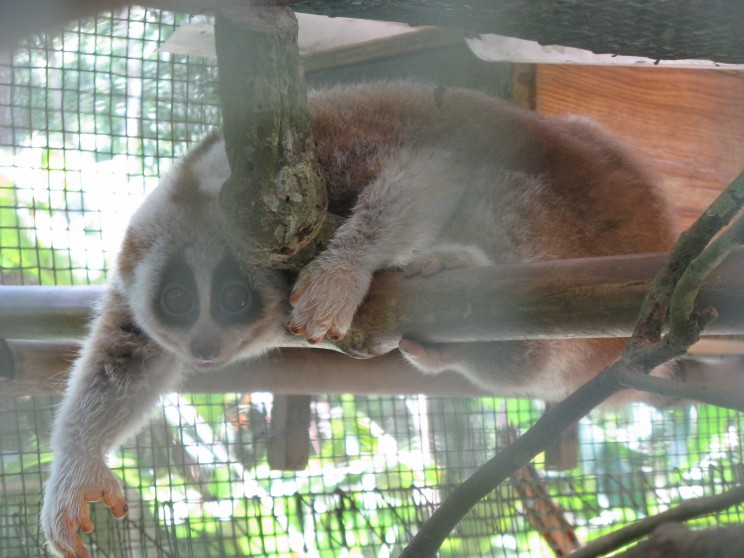Charles Darwin was widely known as a travel writer and natural historian in the twenty years before On the Origin of Species appeared in 1859. The Voyage of the Beagle was a great popular success in the 1830s. But the radical theories developed in the Origin had been developed more or less in secret during those intervening twenty years.
The post The impact of On the Origin of Species appeared first on OUPblog.
By Mary Blair
Slow lorises are enigmatic nocturnal primates that are notoriously difficult to find in the wild. The five species of slow loris that have been evaluated by the International Union for the Conservation of Nature’s Red List of Threatened Species are classified as threatened or critically endangered with extinction. So, how did one end up recently on the set of Lady Gaga’s music video? Lorises don’t make good pets or video props, especially as they are the world’s only venomous primates. But, unfortunately, it is easier to see a loris as an exotic pet in a Youtube video or on Rihanna’s shoulder as a photo prop than it is to see them in the wild.
In my current research at the Center for Biodiversity and Conservation at the American Museum of Natural History, my team is surveying for Bengal (Nycticebus bengalensis) and pygmy slow lorises (N. pygmaeus) in Vietnam to determine their population status – how many lorises remain across different key sites in Vietnam, and how their current numbers compare to previous surveys. I have written before about the challenges my team has faced searching for these elusive creatures, but this time, I’d like to discuss the broader difficulties of searching for low-density, rare animals, and how knowledge gaps about these creatures can preclude the development of effective management plans for their conservation.

Intensive fieldwork on Vietnam’s primates only began in the mid-1990s, focusing on those species assessed to be the most in danger of extinction, especially gibbons (Nomascus spp.) and colobines such as snub-nosed monkeys (Rhinopithecus avunculus), doucs (Pygathrix spp.), and leaf monkeys (Trachypithecus spp.). Comparatively little research to date has focused on species assumed to be common such as the macaques (Macaca spp.) and the nocturnal lorises (Nycticebus spp.). These groups are presumed common because they seem to be able to persist in more diverse habitats including agroforest and regenerating forest, while gibbons, doucs, snub-nosed and leaf monkeys are found in established primary or secondary forests, which are rapidly depleting in Vietnam. As a result of this assumption, very few studies have focused on macaques or lorises in Vietnam and thus, there is very little if any information available to accurately assess their conservation status.
Now that researchers have started collecting data more intensively on slow lorises in Vietnam, we are finding that they are at such low densities that it is difficult to accurately calculate their density with statistical precision. However, as more and more researchers choose to focus on nocturnal, rare mammals like lorises across the globe (from owl monkeys to galagos to colugos), we can synthesize across our efforts to learn from each other, refine our methods, and generate more appropriate statistical models. In addition to continuing our surveys, we also working to raise awareness about threats to slow loris populations in Vietnam, and we are training local forest rangers and researchers to conduct ongoing population monitoring.

Ironically, in this case, there was the least information available about the animals assumed to be the most common. Without fundamental data on population status or distribution, it is difficult to either build effective conservation management plans for slow lorises or attract the federal and private funding necessary to implement such plans. And as such, major conservation actions in the region to date have focused on higher profile primate species, for which there is more information about conservation status. We are finally moving towards having enough scientific information to design a plan of action for improved conservation management of slow loris populations in Vietnam.
In Indonesia, at least 15,000 lorises are trafficked each year for the exotic pet trade. Numbers are not available for Vietnam or other countries in Mainland Southeast Asia, but our work so far suggests that pressure from the trade remains quite high. Our upcoming work in Vietnam, funded by the US National Science Foundation, will expand our research to include social science approaches to better inform policy makers about the underlying social and economic drivers of illicit trade in lorises. You can learn more about what other intrepid loris researchers are doing and how you can help to raise awareness and decrease demand for these endangered animals as exotic pets and photo props.
Dr. Mary Blair is the Assistant Director for Research and Strategic Planning at the Center for Biodiversity and Conservation at the American Museum of Natural History. Her research explores how knowledge of evolutionary processes can inform conservation planning. Her work in Vietnam is supported in part by the Disney Worldwide Conservation Fund and by a US National Science Foundation Science, Engineering, and Education for Sustainability Fellowship under Grant No. NSF-CHE-1313908. Mary has blogged about her work in Vietnam for the Museum’s Fieldwork Journal and for the New York Times, and is the author of Primate Ecology and Conservation. You can follow Mary on Twitter @marye_blair. Any opinions, findings, and conclusions or recommendations expressed in this material are those of the author and do not necessarily reflect the views of the U.S. National Science Foundation.
Subscribe to the OUPblog via email or RSS.
Subscribe to only earth and life sciences articles on the OUPblog via email or RSS.
Image credits: (1) A pygmy slow loris (Nycticebus pygmaeus) at the Endangered Primate Rescue Center in Cuc Phuong National Park, Vietnam. Photo by Dr. Mary Blair. Do not reproduce without permission. (2) A Bengal slow loris (Nycticebus bengalensis) at the Endangered Primate Rescue Center in Cuc Phuong National Park, Vietnam. Photo by Nolan Bett, used with permission.
The post Tracking down a slow loris appeared first on OUPblog.

With International Museum Day approaching on May 18, let's browse the blogs of some museums on WordPress.com -- from premier art institutions to science and natural history organizations.
Shooting the Rapids, oil on canvas, 1879, by
Frances Anne Hopkins
We were doing farm chores and driving around in truck the other week with the radio set to CBC, as usual, when I caught a bit of music and Shelagh Roger's comment that it was based on the Caldecott Honor book by Holling Clancy Holling -- long appreciated by homeschoolers as an author of marvelous living geography books
I noticed this morning while feeding the chickens that all eight roosters were outside in the pen. This is unusual because the four at the top of the pecking order generally stroll around the pen, lording and swanning around, while the four at the bottom of the pecking order quake and cower on the roosts in their little coop. But they were all outdoors this morning. I neared the door, to fill the
One of the kids' jobs in the spring and summer is to keep an eye on the sump pit in the garage, to fish out anything or anyone that's not supposed to be in there. This morning Laura discovered a tiger salamander (Ambystoma tigrinum var. melanostictum), which is quite common in these parts of the province; we're at the northern edge of their range. Tiger salamanders are part of the
Late last spring, the kids asked if we could have "bird school" all summer. So, in addition to our various field guides, we pulled all of the bird books off the shelves and grouped them together in the living room on the coffee table. Indoors and out, the kids read the various books themselves, to each other, and asked for readalouds of others. I kept meaning to put all of the titles in a post,
Dawn at By Sun and Candlelight has this season's installment, in words and plentiful pictures, of the latest Field Day, just in time for late Spring. Rainbows, skinks, flowers, birds and bird books -- something for everyone, especially on an early Spring morning or a quiet, rainy day. Thank you, Dawn, for the wonderful idea and for continuing, season after season.
Appropriately enough, we had word from the county yesterday that our 900+ new shelterbelt trees will be ready for pick up by May 9th. Tom phoned to borrow the county's tree planter, which make the process much easier, and we're getting some fabric mulch this year so that the kids and I don't have quite as much weeding.
Above is a shot of just a few of the 1,400 saplings we planted last year,
Palm tree (friend's garden)
Roots of a West Indian almond tree (friend's garden)
Another palm tree (friend's garden)
Strelitzia (Bird-of-Paradise) in my parents' garden
Our friend, the donkey spider (since removed to a safe place, for all concerned, in the garden away from the house)





Thanks very much for all of the excellent ideas about places to visit and links to online resources! I am, at heart, insatiably curious, and I love learning. I would love to travel around the country one day (and eventually, the world) and see what I can see! :)
Thank you for bringing up this awareness. Went to National museum in Calabar here yesterday not knowing that such event is close by. A historical place as the first story building in this part of the world and incidentaly was colonial residency built around 1840. I will celebrate the World Museum Day in my own little way with collection of shots i got starting from 17th. Kudo to WordPress.
I had no idea there was an International Museum Day! I certainly have my work cut out for myself. I miss going to museums; did lots of that when living in New York. Thanks for all these links. Good job!
Absolutely LOVE this photo, love the angles, the curves, everything.
Thanks for adding new-to-me museum sites to explore. I’d like to add one more, The British Museum blog. A good portion of my uni years was spent in the physical space, so it’s lovely to be able to keep up virtually.
Hear! Hear! As a young lad just after WW2 my greatest joy was each Saturday to vsit the science museum in South Kensington, London. Today aged 78yrs I couldn’t face all the travelling and walkng involved in museum visits and so I’m delighted if you are offering us all virtual reality museum visits. At my age I suspect I might end up as an exhibit in the natural history museum.
Thanks! The Buffalo History Museum led me to Teaching Children About the Underground Railroad, a fascinating post that mentioned a book by Vaunda Micheaux Nelson called Almost to Freedom, told from the point of view of a young girl’s rag doll, which led me to the Museum of International Folk Art in Santa Fe, New Mexico. I loved the journey.
We’re in the process of our project, but the Miniature Natural History Museum and Laboratory will be totally done by next Spring. You can see our progress here on our WordPress blog: a real 1:12 scale miniature museum. http://theminiaturenaturalhistorymuseumandlaboratory.com/
This is an interesting panorama. I like how many museums show an out-of-the-box exposition as the Immigration Museum in Buenos Aires or the Torture Museum in Prague.
Great article.
The Black Diamond Heritage Centre Museum in Bulli, Australia is also on WordPress – http://blackdiamondheritagecentrebulli.wordpress.com/about/ – I’ve found that WordPress is a nice format for a Museum blog.